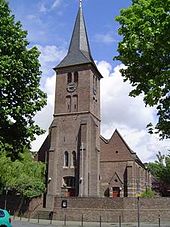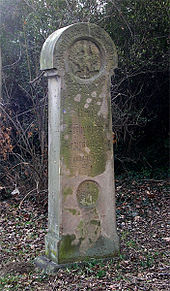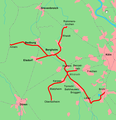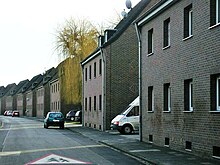Niederaussem
|
Niederaussem
City of Bergheim
|
|
|---|---|
| Coordinates: 50 ° 59 ′ 15 ″ N , 6 ° 40 ′ 21 ″ E | |
| Height : | 83 m |
| Area : | 7.99 km² |
| Residents : | 5751 (Jun. 30, 2019) |
| Population density : | 720 inhabitants / km² |
| Incorporation : | 1st January 1975 |
| Postal code : | 50129 |
| Area code : | 02271 |
Niederaussem is a district of the district town Bergheim in the Rhein-Erft district in the state of North Rhine-Westphalia . With almost 6,000 inhabitants, the village is one of the large districts in Bergheim. Niederaussem was an independent municipality until 1975 and is now also known nationwide due to the Niederaussem power plant built in 1961 .
geography
Geographical location
Niederaussem is about 18 km as the crow flies west of Cologne at about 80 meters above sea level. The highest Niederaussemer elevation since 2009, at 128 meters above sea level, is the Bethlehemer Höhe in the recultivated Bergheim open-cast mine. Until 2009, the Wiedenfelder Höhe, made up of overburden from lignite mining, was the highest point in the village at 126.4 meters. The Bohnenbach flowed through Niederaußem and is now canalised. The Gillbach rises at the Niederaußem power plant, right on the border with Auenheim. Niederaussem lies on the edge of the Zülpicher Börde and on the northern foothills of the Villerück , which in turn belong to the Cologne Bay . In terms of economic geography, Niederaussem is in the Rhenish lignite district .
Neighboring places
| Monks' yards | Rheidt-Hüchelhoven | Büsdorf |
| Auenheim |

|
Glessen |
| Wiedenfelder Höhe | Bergheim | Oberaussem |
climate
Niederaussem lies in the transition zone from a temperate maritime climate to a continental climate with mild winters and moderately warm summers. The annual precipitation is in the good Germany mean. Due to the Eifel Barrier, the place is protected and protected by rain from westerly winds, which can also have a blow-dryer effect. The climate in Niederaussem is also influenced by industry. In winter, the temperature can therefore be slightly higher than in the surrounding area. In addition, there can be cooling precipitation and industrial snow, with snow days in Niederaussem being an absolute rarity.
history
Prehistory and early history
Various finds prove human life in Niederaussem as early as the younger Stone Age (4000 BC). A burial mound field was preserved in the Bethlehem Forest until the 1950s . It fell victim to the open pit. In the Gallic War around 50 BC The Romans also took over the area of today's Niederaussem. In the fertile soils of the Gillbach they set up single farm settlements. Roman remains are found again and again in the present. Roman grave boxes were found during the construction of the Fortuna-Nord briquette factory. When the Barbara School was built in the 1950s, a Roman aqueduct was found, which is repeatedly visible in new buildings in the upper village. In Franconian times the single farm settlements became farm groups. According to today's knowledge, the place name and patronage of Niederaußems as well as the Fronhof Holtrop come from the same time .
middle Ages
At the end of the 9th century, the Normans also attacked the Niederaussem area. The place was then in the border area between Gillgau , Kölngau and Jülichgau . The Holtrop Fronhof was burned down. This caused the Lords of Holtrop to fortify the courtyard in the form of a residential tower during the reconstruction. The first Holtrop Castle was built . At the end of the first millennium, Otto I also ruled over the Niederaussem areas. He gives his ducal violence but at the Cologne Archbishop Bruno I. from. He mentioned Niederaussem for the first time as "Ouleshem" (outside) in a document in 962. In 1028, the feudal sovereignty over Niederaussem then falls through a gift from the Count Palatine Ezzo to the imperial abbey Kornelimünster . After Otto II received his diploma in 973, the Archbishops of Cologne continued to have power over the areas in which Niederaussem is also located. After the Battle of Worringen, however, this power passed to the County of Jülich, which later became the Duchy of Jülich . Over the years Niederaussem developed from a small hamlet to a farming village. As early as 1304, the St. Johann Baptist Church was built in place of a Franconian chapel, from which today's parish church emerged. For the Niederaussemer, the 16th century was marked by wars, raids and the Reformation . During the war for Geldern , Holtrop Castle was also destroyed by the troops of Emperor Charles V. Between 1582 and 1589, the Catholic Niederaussem briefly became Protestant.
Modern times
The 18th century became more peaceful for Niederaussem and there were no dramatic wars. Between 1727 and 1738, Holtrop Castle was converted into a baroque palace. The population grew steadily. In 1798 Niederaussem had 259 inhabitants. In October 1794, French troops occupied the Rhineland . In 1798 Niederaussem was incorporated into the Département de la Roer and belonged to France for 20 years until the Erftland was incorporated into the Kingdom of Prussia on April 5, 1815 . The change from an agricultural village to an industrial community took place in the early 19th century with the discovery of the first brown coal . The first pits opened in the immediate vicinity and the briquette factory and later the Fortuna power plant in Bergheim-Fortuna were built near Oberaußem . Since the new industry needed workers, many people switched from agriculture to coal. It also attracted workers from outside and Niederaussem grew.
20th century
The beginning of the 20th century in Niederaussem was marked by an enormous economic boom due to the lignite industry. In 1904 the place received a railway connection. With the construction of the Fortuna-Nord briquette factory in 1939/1941 (today Fortuna-Nord coal refining company ), Niederaussem became an industrial location. As an industrial location, Niederaussem also became a strategically important location during World War II . Niederaussem was the victim of numerous bomb attacks, especially in 1944 and 1945. The Second World War for the Niederaussemers reached its climax in February 1945 when the front rolled over to Niederaussem. On March 2, 1945 at 2 p.m. Niederaussem was captured and occupied by the Americans. The population had to stay in the parish church until March 5th before they were allowed to go back to their homes. After the war, the local industry expanded. The Fortuna-Garsdorf opencast mine , at that time the largest lignite mine in the world, was opened. Holtrop Castle fell victim to the mine and was laid down in 1958. The influx of refugees from the former German areas in the east caused the population to rise further. The start of construction for the Niederaussem power plant in 1961 is another chapter in Niederaussem's industrial history. It was expanded in stages, for the last time between 1997 and 2002 with the BoA plant (lignite power plant with optimized plant technology). Today the Niederaussem power plant is one of the largest lignite power plants in the world. Further power plant blocks are planned. Industry paid off for the community of Niederaussem. Thanks to large trade tax revenues, the municipal treasury was well filled. The commune was one of the richest in Germany. The tennis hall, the swimming pool and some school buildings bear witness to this time. On January 1, 1975, the Niederaussem community was dissolved and incorporated into the district town of Bergheim.
Niederaussem in transition
A few years later, the Fortuna-Garsdorf opencast mine was opened southwest of Niederaussem .
After the Second World War, the construction of the Niederaussem power plant began.
21st century
Niederaussem continued to grow, the opencast mines were charred and recultivated. The last open pit mine in the Niederaussem area was completely renatured in 2012. The mining and power plant company RWE / Rheinbraun lost numerous jobs as a result of rationalization measures. The former bond between the company and the people of Niederaussem was lost. A clear sign of this were protests against plans to expand the power plant.
The settlement of the "Im Euel" building area, where a shopping center was opened in 2008, was planned. An environmentally friendly “ heat pump settlement ” was planned as a pilot project ; In addition, the houses should get their energy from solar systems.
politics
coat of arms
The Niederaussem coat of arms dates from the 1960s. The Holtrop eagle, based on the abandoned Holtrop Castle , is supposed to symbolize the history of the place. The black bar stands for mining and the lightning for energy production. Today the coat of arms is used by numerous local associations and institutions. In addition, the coat of arms is part of the Niederaussem flag . The flags and banners , which show the Niederaussem coat of arms on a red and white background, are also available for private individuals and decorate the place at public events and celebrations, and especially during the shooting festival.
religion
The place, which belongs to the Archdiocese of Cologne, was influenced by Catholicism until the Second World War . The Christian faith is deeply rooted in Niederaussem, numerous wayside crosses, picture sticks and, above all, the lively community life testify to this as well as the elaborately designed Corpus Christi procession that passes through the town every year. Niederaussem is one of the few places of its size that has two Catholic churches. In addition to the Church of St. Johann Baptist , the Church of St. Paulus was built as the second Catholic church in the new building area on Paulusstrasse. In 2005 Niederaussem was very committed to the XX. Involved in World Youth Day in Cologne. A large number of pilgrims were accommodated in the village and the power station parking lot was a central transfer point for pilgrims on their way to the papal masses . The buses commuted directly between Niederaussem and Marienfeld .
As a result of the expulsion from the eastern German territories, a Protestant congregation was created with around 2,100 believers today. In 1955 the Church of the Redeemer was built. A special sign of the lived brotherhood between the denominations was experienced during the big joint celebrations for the 700th anniversary of the documented existence of the Christian churches in Niederau and Oberaußem in 2006.
With the increasing number of migrants, Islam is also practiced in Niederaussem. The nearest mosque is in the Quadrath-Ichendorf district .
Infrastructure
traffic
Street
Historically, the Alte Landstrasse forms the former main traffic artery and "north-south axis" of Niederaussem. Today the place has, due to the industry, the relatively high population and the convenient location, a high volume of traffic. The B 477 runs directly through the town center and forms the new "north-south axis" of Niederaussems as Dormagener Straße. Niederaussem has a connection to the federal motorway 61 via this road . The Bergheim / Elsdorf motorway junction is five kilometers away. To the east, traffic is directed via Oberaußemer Straße (L 91) in the direction of Cologne , Pulheim , Glessen and Oberaußem . Auenheimer Strasse and Werkstrasse open up the west of Niederaußem and lead traffic in the direction of Bedburg , Grevenbroich and Auenheim . These streets will be relieved of traffic by the L 279, which runs along the Mönchshöfe. It is planned to expand this road to the east and thus create a direct connection to the B 59 at Stommeln , which bypasses Asperschlagstrasse as well as Büsdorf and Fliesteden . Paulusstrasse and Brieystrasse are also important for inner-city traffic, as east north-south connections and feeders to schools and sports facilities. The Asperschlagstraße connects Niederaussem and Büsdorf.
Public transport
Niederaussem received a rail connection on December 19, 1904. Even before the First World War, it was planned to expand the railway line leading through the town as a bypass of the Cologne railway junction and part of the strategic railway embankment. However, this was not realized. Passenger traffic on the railway line initially ran on the Rommerskirchen - Rheidt / Hüchelhoven - Niederaussem - Oberaussem - Fortuna - Quadrath / Ichendorf line, later the trains ran directly between Niederaussem and Bergheim . Passenger traffic was discontinued in the 1970s. The tracks in the direction of Bergheim fell victim to the opencast mine. Today the route between Niederaussem and Rommerskirchen is used for freight transport. This route crosses the North-South Coal Railway and the Hambach Railway in Niederaussem . Since the discontinuation of local rail transport, local public transport has been using the bus services of the Rhein-Erft-Verkehrsgesellschaft, whose central transfer point in the north of Bergheim is the "Niederaußem / Oberaußemer Straße" stop.
- For more information on rail traffic in Niederaussem, see → Bergheimer Kreisbahn
- For more information on rail traffic in Niederaussem, see → Strategic embankment
bus connections
| line | course |
|---|---|
| 924 | Niederaussem - Auenheim - Rath - Bedburg (Erft) |
| 961 | Bergheim - Quadrath - Oberaußem - Niederaußem - (Büsdorf) - (Fließsteden) - Glessen - Dansweiler - Brauweiler - Lövenich - Cologne / Weiden |
| 970 | Niederaussem - Büsdorf - Fliesteden - Stommeln - Pulheim - Cologne / Bocklemünd |
| 971 | Bergheim - Oberaussem - Niederaussem - Rheidt - Hüchelhoven - Gill - Rommerskirchen / Eckum |
| 923 | Bergheim ring road |
education
Niederaussem is equipped with the following schools: Catholic elementary school, secondary school on the local border with Oberaussem and a special school with the special focus on learning. There are also kindergartens and sports facilities such as the indoor swimming pool on Brieystraße.
consumption
With numerous grocery and clothing stores, the place is the focal point for the surrounding towns. A weekly market takes place every Wednesday. There is a small industrial area with numerous companies. Construction companies and a tobacco shop as well as market gardens are located in the village.
Culture
Cultural development

The cultural development in Niederaussem can be traced back primarily to the town's Catholic past. Niederaussem already had its own church around 1300. Christian traditions such as the Corpus Christi procession are maintained with great effort to this day. The St. Katharinen Rifle Brotherhood in Niederaussem was founded on October 1, 1444, primarily for faith, but also for custom and home. It is also a permanent cultural asset of Niederaussem to this day.
Furthermore, the cultural development of the place is influenced by agriculture . The annual course in working life but also in customs was based on sowing and harvesting. From this, customs such as the May Festival developed in a broader sense .
After the Second World War, evangelical Christians came to Niederaussem with their own customs and traditions through flight and expulsion. Niederaussem grew to several thousand inhabitants. The former customs and associations, which relied on a great cohesion in the formerly small farming village, had it increasingly difficult, so new customs such as the previously little celebrated Carnival , in which old associations also participate today , were able to establish themselves.
Regular events
- Every spring there is a big shooting festival with a parade.
- The carnival society Fidele Geister organizes several carnival sessions in each session. At the end of the respective carnival session, the big parade goes through the town on the Sunday before Shrove Monday with up to 800 participants.
- On April 30th of each year, the dance into May takes place in the so-called "Green Lung". The senators of KG Fidele Geister organize this event.
- The soccer department of SV Erftstolz invites you to Father's Day on Ascension Day.
- Fair is no longer celebrated. The open day of the volunteer fire brigade at the end of May each year has replaced this festival.
- In October, the men's choir Cäcilia invites you to the festival in October. The KG Fidele Geister celebrates their spark bivouac in their own wagon building hall with their carnival friends.
dialect
The Kölsch dialect , which is a variant of Ripuarian, is spoken in Niederaussem . As is usual for the Kölsch language in rural areas, there are also some deviations and peculiarities to the usual Kölsch in Niederossem, as the place is called in the dialect.
architecture
The “old village” is typically characterized by brick houses and farmsteads for the region . In the center there are also half-timbered buildings , such as the old smithy on the village square.
In the "New Village" there are several streets that are characterized by uniform miners' houses.
Buildings
- Niederaussem power plant
- St. Johann Baptist (Niederaussem)
- St. Paulus (Niederaussem)
- Church of the Redeemer (Niederaussem)
- old school building
- small monk's court
- Gut Meulshof
Green areas / local recreation
Parks
In 1965 a park was created in place of a former manor . It bears the name "Green Lung" and serves as compensation for the large-scale industry on site. The park is dominated by large meadows with curved walking paths. Until 2008 there was a pond with a fountain in the center of the green lung. A water playground was built in its place today. The park trees planted most frequently in the complex are plane , chestnut , birch and yew .
A second park is located in the east of Niederaussem. Its design contrasts with the green lung. The complex is laid out like a forest and is elongated. There is both a toboggan hill and an adventure playground in it.
graveyard
In Niederaussem there is a municipal cemetery with a mortuary and a cemetery chapel . The cemetery has some historical tombs and old trees. There are double graves, single graves, deep graves and urn graves. It is planned to create opportunities for alternative burials. For example, urn fields are to be laid out on a central meadow.
Recreation
The Wiedenfelder Höhe borders directly on the town . It is a 126 meter high recultivated high tip. Numerous hiking and cycling trails run along it. Niederaussem is connected to the regional and national cycle path network.
Sports
Niederaußem is home to the largest sports club in Bergheim, SV Erftstolz e. V. Niederaussem 1926. Over 2300 athletes train in the football, swimming, gymnastics - dancing - athletics and tennis departments.
Every year, the footballers invite all hobby teams from Niederaussem to the "A village plays football" tournament. The counterpart is the village hall tournament in winter.
The swimming department with 1300 members is the largest swimming club in the Rhein-Erft district and is also among the top 30 of the largest swimming clubs in North Rhine-Westphalia. The Erftstolz swimming department was instrumental in founding a sponsoring association to take over the municipal swimming pools in Quadrath-Ichendorf , Glesch and Zieverich. In addition, the swimmers operate the indoor pool in the city of Elsdorf on their own.
In the gymnastics group, mother and child groups start from one year. The German sports badge is removed annually from the athletes .
The tennis department operates its own tennis facility with eight courts and a clubhouse.
Other sports clubs in Niederaussem are the Außenem handball club, the RWE company sports association and several amateur soccer teams.
Town twinning
The municipality of Niederaussem was one of the first German municipalities to enter into a partnership with a French city. Contacts with the Lorraine city of Briey have existed since 1957 .
Numerous places in Niederaussem testify to the partnership between the two "cities", which is still alive today. B.
- Place de Briey
- Brieystrasse
- Lorraine ring
- Metzstrasse
- Nancy Street
The Albert-Einstein-Realschule operates a regular student exchange with Briey as part of the French lessons.
See also
Individual evidence
- ↑ https://www.bergheim.de/statistik.aspx
- ^ Federal Statistical Office (ed.): Historical municipality directory for the Federal Republic of Germany. Name, border and key number changes in municipalities, counties and administrative districts from May 27, 1970 to December 31, 1982 . W. Kohlhammer, Stuttgart / Mainz 1983, ISBN 3-17-003263-1 , p. 300 .
Web links
- Association of Heimatfreunde Niederaußem-Auenheim
- History of Niederaussem
- Website of the city of Bergheim
literature
- Niederaußem Chronicle of a Community - Kurt Schmitz (1974)
- All around. 50 Years Church of the Redeemer Niederaussem - Christoph Tebbe (2006)
- The Fortuna - Detlef Witt power plants






















